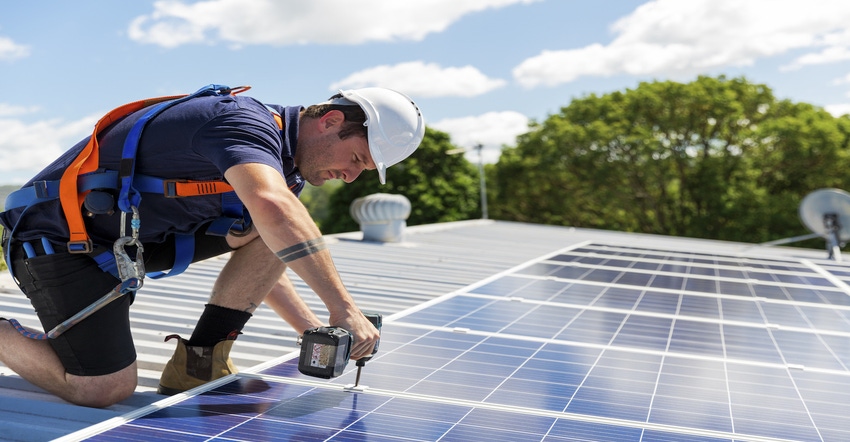Fall Protection for Roofers Performing Solar, Metal Wall Panel Work
In this Q&A, Cole Roofing's Loss Control Manager Steve Sohasky discusses the best safety tips for roofers working on solar or metal panel wall work.

In this Q&A, Steve Sohasky, loss control manager at Cole Roofing, discusses staying safe while working on solar or metal panel wall work.
Roofing & Exteriors: According to OSHA, falls are the leading cause of death in construction. What precautions should employers take to keep their workers safe?
Sohasky: One of the first things would be to assess the hazards of the work area prior to the start of work. By viewing the project before you start you can determine what equipment you will need, how much of it you will need and where it can be installed or placed and what training will be needed. While internet aerial photos are convenient they may not depict the current conditions. On a new construction project, the conditions a month ago are likely to not be the same today so it is important to see what the condition of the work area is, how you are going to access your work areas and what other trades may be in that area. Using this information, you can create a good fall protection and general site safety plan, a little planning upfront can do a lot to prevent injuries and delays in work as the project moves along.
R&E: In 2019, the United States Court of Appeals for the Ninth Circuit decided that rooftop solar panel installation is not “roofing work” under OSHA regulations. How does that affect roofing contractors who are tasked with these jobs?
Sohasky: While many commercial roofers are well versed in both conventional and unconventional fall protection methods, they do not realize that some of these methods will only apply to “low-slope” roofing and not to all work on the roof. While having a warning line system 6 feet from an unprotected edge may work for low slope roof work, that does not apply for the installation of solar panels and other trade work. In some areas, a warning line system may be allowed for fall protection but at 15 feet back from the unprotected edge, not the normal 6 or 10 feet that many commercial roofers are used to. Another method that does not follow over to solar panel installation is the safety monitor system. This is specifically designed for low slope roof work and cannot be used for solar panel installation or other trades but is very common in the installation of low slope roof systems.
RE: What are the biggest challenges or obstacles facing roofers when performing solar or metal wall panel work? Does this work increase fall hazards?
Sohasky: Besides maintaining manufacture warranties as in many cases, the manufactures of the solar panels or metal wall panels are not the same as the roof system so there can be some gray areas where the two systems meet so anything along those lines can be addressed before. Licensing is a large part of it, not only would you have to be approved by many manufactures to install products but solar presents many more hazards and situations that many roofers may not be equipped for. While metal wall panels are part of the building envelope and in my opinion provide an easier transition for a roofing company, they also involve working on a vertical face of the building versus a horizontal surface so scaffolding and various types of mobile elevated work platforms add to the hazards and the training required to execute this. Solar requires much more education on the electrical side of things both in skillset and safety. The solar panels are going to be powered when the sun is out and can’t just be turned off by flipping a switch as with some other electrical applications. Professional engineers are also involved and are a more complicated overall installation.
R&E: What must roofers do differently while performing this type of work?
Sohasky: When it comes to solar panels a professional engineer should always be involved to confirm that the substrate can accommodate the load of what is being installed. When you have a professional engineer involved this is a good time to engineer in some permanent fall protection anchor points because as the solar array is installed fall protection may become more difficult to maintain. In addition, if you can have additional anchorage points installed it helps tremendously when you go back to service the roof or any other systems and normally can be a good upsell to the customer. As I mentioned above there are also electrical hazards that are more prevalent than found on your typical roofing job so increased training and education for electrical hazards should be incorporated into your training program
R&E: How prevalent have these types of installations become?
Sohasky: You see both solar and metal wall panels more and more in construction projects these days and due to them tying into the work of roofers it does make sense for roofers to be involved in these but proceed with caution. Solar seems to be popular in areas where grants, tax credits and other incentives can be found. Metal wall panels continue to be increasingly a part of the building envelope on new construction projects with not as much in existing building renovations.
Read more about:
low slope roofingAbout the Author(s)
You May Also Like




